A Comparative Analysis: Quantitative-Qualitative Debate in Research
VerifiedAdded on 2020/03/16
|9
|2033
|136
Essay
AI Summary
This essay critically examines the ongoing debate between quantitative and qualitative research methods. It begins by outlining the fundamental differences between the two approaches, highlighting how quantitative methods rely on numerical data and statistical analysis to establish objective measurements, while qualitative methods focus on descriptive and interpretive analysis of non-numerical data to understand opinions and contexts. The essay explores the historical context of the debate, tracing the arguments for and against the mixed use of these methods. It then delves into the strengths and limitations of each method, using examples from sports and exercise research to illustrate their applicability. The discussion includes the use of quantitative methods in quantifying sports data and the descriptive nature of qualitative methods in explaining exercise effects and player-manager relationships. Finally, the essay addresses the mixed-methods approach, discussing the challenges and potential benefits of integrating both quantitative and qualitative data in research, concluding that both methods are valuable in the research process, with their individual techniques offering different insights.
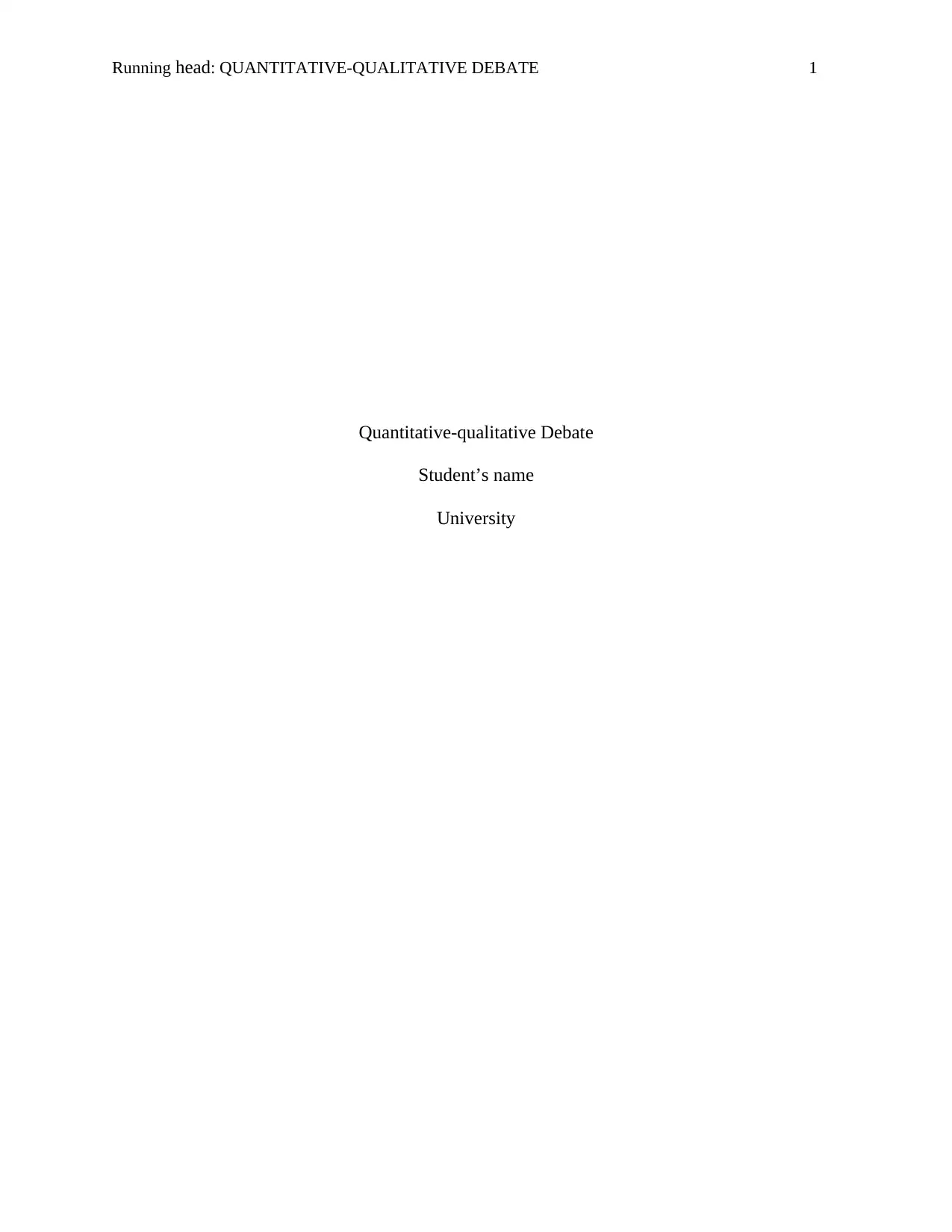
Running head: QUANTITATIVE-QUALITATIVE DEBATE 1
Quantitative-qualitative Debate
Student’s name
University
Quantitative-qualitative Debate
Student’s name
University
Paraphrase This Document
Need a fresh take? Get an instant paraphrase of this document with our AI Paraphraser
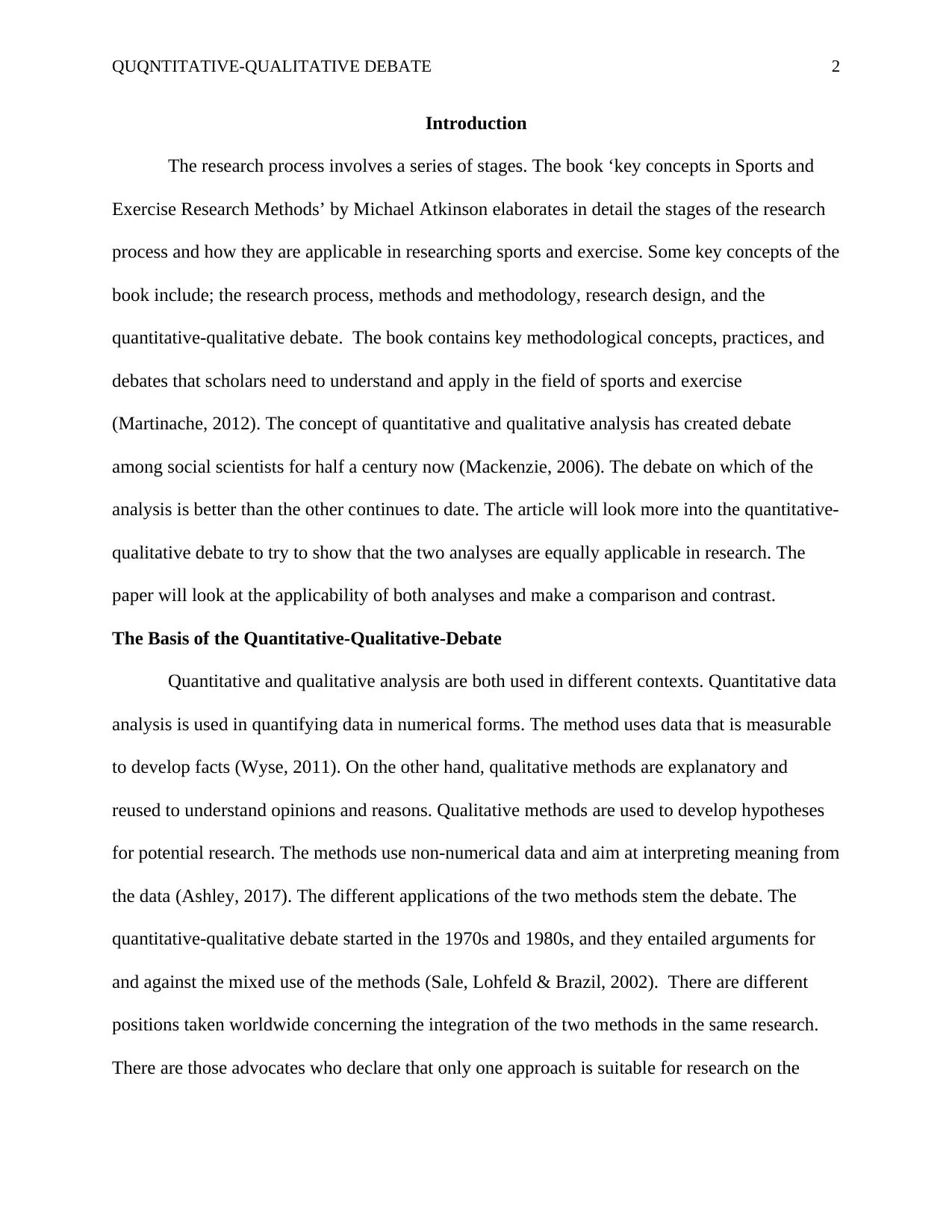
QUQNTITATIVE-QUALITATIVE DEBATE 2
Introduction
The research process involves a series of stages. The book ‘key concepts in Sports and
Exercise Research Methods’ by Michael Atkinson elaborates in detail the stages of the research
process and how they are applicable in researching sports and exercise. Some key concepts of the
book include; the research process, methods and methodology, research design, and the
quantitative-qualitative debate. The book contains key methodological concepts, practices, and
debates that scholars need to understand and apply in the field of sports and exercise
(Martinache, 2012). The concept of quantitative and qualitative analysis has created debate
among social scientists for half a century now (Mackenzie, 2006). The debate on which of the
analysis is better than the other continues to date. The article will look more into the quantitative-
qualitative debate to try to show that the two analyses are equally applicable in research. The
paper will look at the applicability of both analyses and make a comparison and contrast.
The Basis of the Quantitative-Qualitative-Debate
Quantitative and qualitative analysis are both used in different contexts. Quantitative data
analysis is used in quantifying data in numerical forms. The method uses data that is measurable
to develop facts (Wyse, 2011). On the other hand, qualitative methods are explanatory and
reused to understand opinions and reasons. Qualitative methods are used to develop hypotheses
for potential research. The methods use non-numerical data and aim at interpreting meaning from
the data (Ashley, 2017). The different applications of the two methods stem the debate. The
quantitative-qualitative debate started in the 1970s and 1980s, and they entailed arguments for
and against the mixed use of the methods (Sale, Lohfeld & Brazil, 2002). There are different
positions taken worldwide concerning the integration of the two methods in the same research.
There are those advocates who declare that only one approach is suitable for research on the
Introduction
The research process involves a series of stages. The book ‘key concepts in Sports and
Exercise Research Methods’ by Michael Atkinson elaborates in detail the stages of the research
process and how they are applicable in researching sports and exercise. Some key concepts of the
book include; the research process, methods and methodology, research design, and the
quantitative-qualitative debate. The book contains key methodological concepts, practices, and
debates that scholars need to understand and apply in the field of sports and exercise
(Martinache, 2012). The concept of quantitative and qualitative analysis has created debate
among social scientists for half a century now (Mackenzie, 2006). The debate on which of the
analysis is better than the other continues to date. The article will look more into the quantitative-
qualitative debate to try to show that the two analyses are equally applicable in research. The
paper will look at the applicability of both analyses and make a comparison and contrast.
The Basis of the Quantitative-Qualitative-Debate
Quantitative and qualitative analysis are both used in different contexts. Quantitative data
analysis is used in quantifying data in numerical forms. The method uses data that is measurable
to develop facts (Wyse, 2011). On the other hand, qualitative methods are explanatory and
reused to understand opinions and reasons. Qualitative methods are used to develop hypotheses
for potential research. The methods use non-numerical data and aim at interpreting meaning from
the data (Ashley, 2017). The different applications of the two methods stem the debate. The
quantitative-qualitative debate started in the 1970s and 1980s, and they entailed arguments for
and against the mixed use of the methods (Sale, Lohfeld & Brazil, 2002). There are different
positions taken worldwide concerning the integration of the two methods in the same research.
There are those advocates who declare that only one approach is suitable for research on the
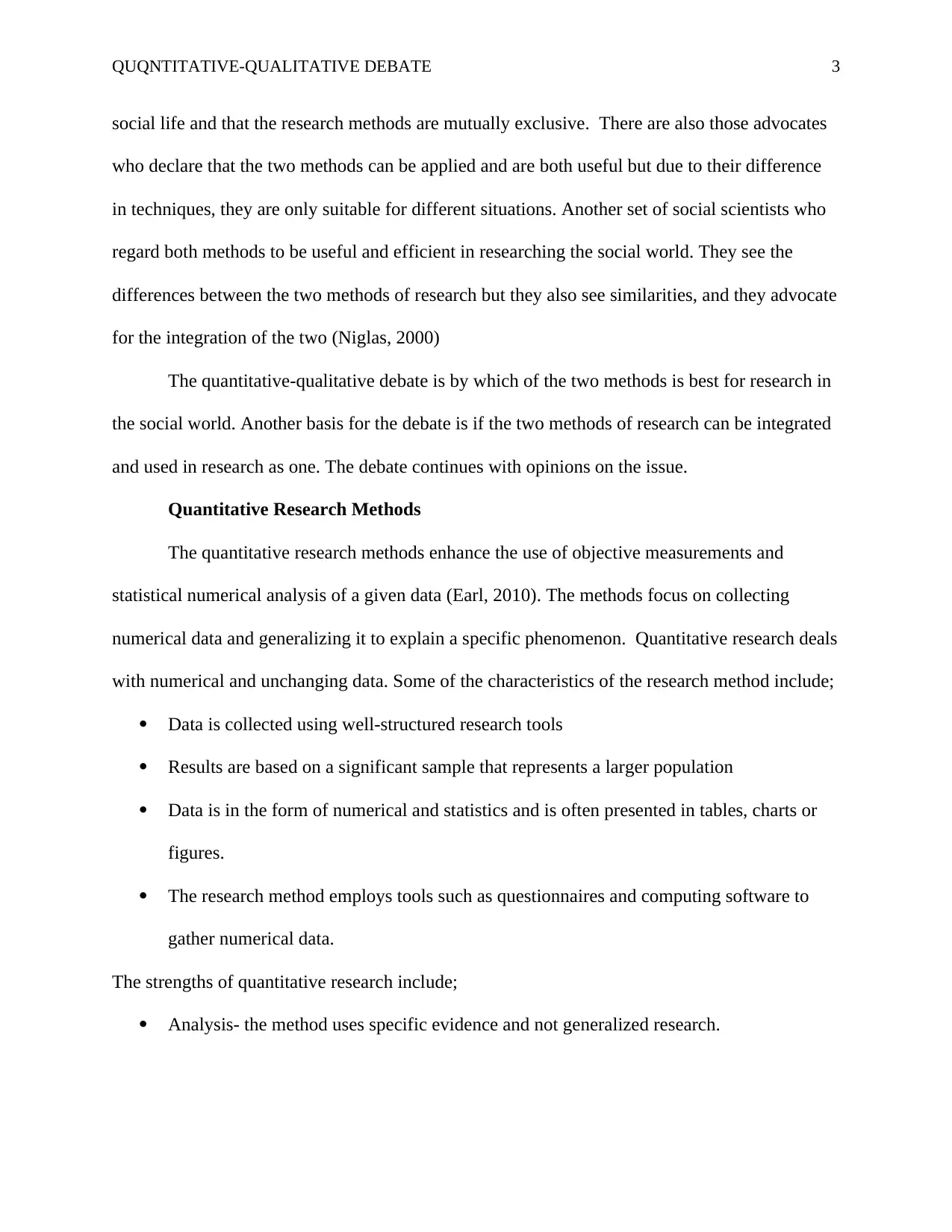
QUQNTITATIVE-QUALITATIVE DEBATE 3
social life and that the research methods are mutually exclusive. There are also those advocates
who declare that the two methods can be applied and are both useful but due to their difference
in techniques, they are only suitable for different situations. Another set of social scientists who
regard both methods to be useful and efficient in researching the social world. They see the
differences between the two methods of research but they also see similarities, and they advocate
for the integration of the two (Niglas, 2000)
The quantitative-qualitative debate is by which of the two methods is best for research in
the social world. Another basis for the debate is if the two methods of research can be integrated
and used in research as one. The debate continues with opinions on the issue.
Quantitative Research Methods
The quantitative research methods enhance the use of objective measurements and
statistical numerical analysis of a given data (Earl, 2010). The methods focus on collecting
numerical data and generalizing it to explain a specific phenomenon. Quantitative research deals
with numerical and unchanging data. Some of the characteristics of the research method include;
Data is collected using well-structured research tools
Results are based on a significant sample that represents a larger population
Data is in the form of numerical and statistics and is often presented in tables, charts or
figures.
The research method employs tools such as questionnaires and computing software to
gather numerical data.
The strengths of quantitative research include;
Analysis- the method uses specific evidence and not generalized research.
social life and that the research methods are mutually exclusive. There are also those advocates
who declare that the two methods can be applied and are both useful but due to their difference
in techniques, they are only suitable for different situations. Another set of social scientists who
regard both methods to be useful and efficient in researching the social world. They see the
differences between the two methods of research but they also see similarities, and they advocate
for the integration of the two (Niglas, 2000)
The quantitative-qualitative debate is by which of the two methods is best for research in
the social world. Another basis for the debate is if the two methods of research can be integrated
and used in research as one. The debate continues with opinions on the issue.
Quantitative Research Methods
The quantitative research methods enhance the use of objective measurements and
statistical numerical analysis of a given data (Earl, 2010). The methods focus on collecting
numerical data and generalizing it to explain a specific phenomenon. Quantitative research deals
with numerical and unchanging data. Some of the characteristics of the research method include;
Data is collected using well-structured research tools
Results are based on a significant sample that represents a larger population
Data is in the form of numerical and statistics and is often presented in tables, charts or
figures.
The research method employs tools such as questionnaires and computing software to
gather numerical data.
The strengths of quantitative research include;
Analysis- the method uses specific evidence and not generalized research.
⊘ This is a preview!⊘
Do you want full access?
Subscribe today to unlock all pages.

Trusted by 1+ million students worldwide
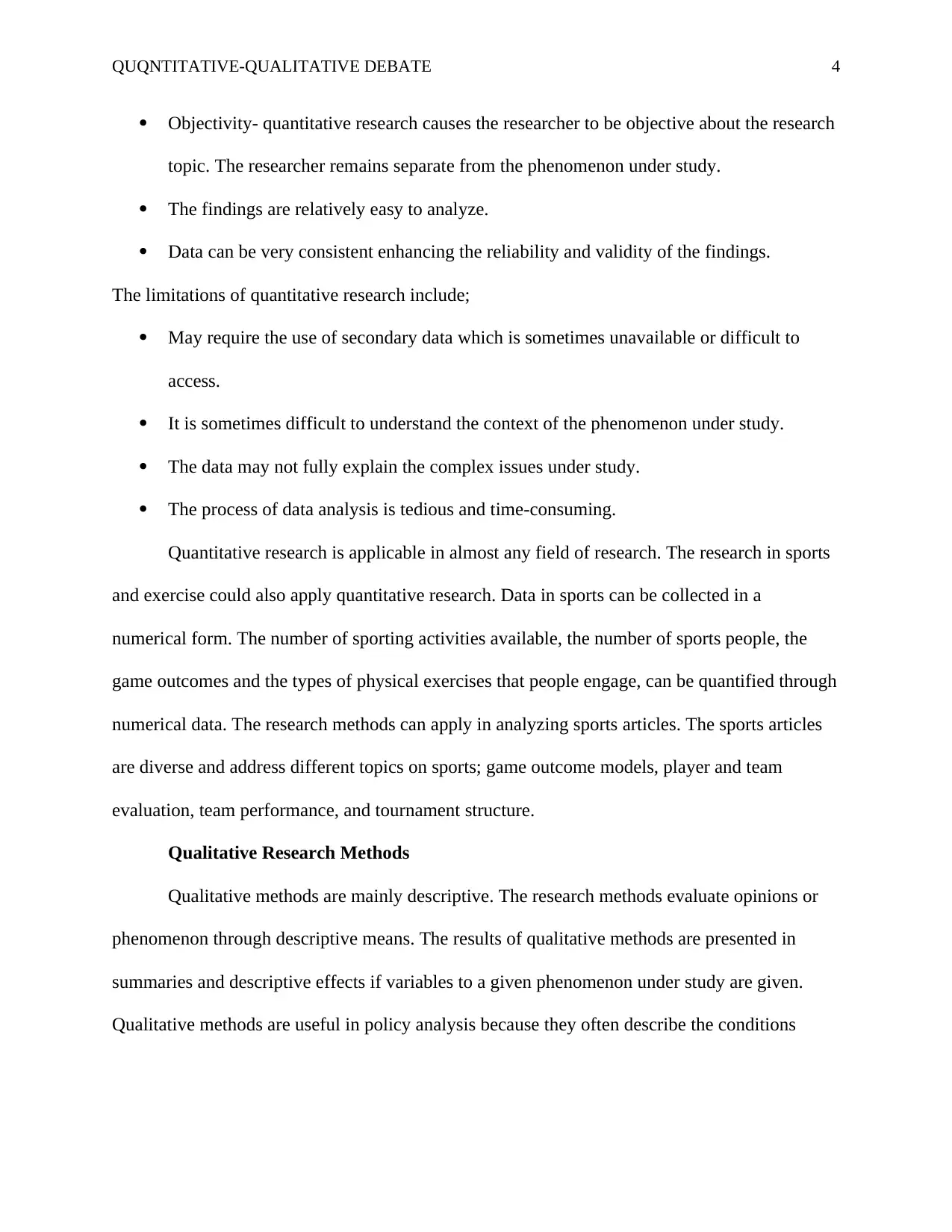
QUQNTITATIVE-QUALITATIVE DEBATE 4
Objectivity- quantitative research causes the researcher to be objective about the research
topic. The researcher remains separate from the phenomenon under study.
The findings are relatively easy to analyze.
Data can be very consistent enhancing the reliability and validity of the findings.
The limitations of quantitative research include;
May require the use of secondary data which is sometimes unavailable or difficult to
access.
It is sometimes difficult to understand the context of the phenomenon under study.
The data may not fully explain the complex issues under study.
The process of data analysis is tedious and time-consuming.
Quantitative research is applicable in almost any field of research. The research in sports
and exercise could also apply quantitative research. Data in sports can be collected in a
numerical form. The number of sporting activities available, the number of sports people, the
game outcomes and the types of physical exercises that people engage, can be quantified through
numerical data. The research methods can apply in analyzing sports articles. The sports articles
are diverse and address different topics on sports; game outcome models, player and team
evaluation, team performance, and tournament structure.
Qualitative Research Methods
Qualitative methods are mainly descriptive. The research methods evaluate opinions or
phenomenon through descriptive means. The results of qualitative methods are presented in
summaries and descriptive effects if variables to a given phenomenon under study are given.
Qualitative methods are useful in policy analysis because they often describe the conditions
Objectivity- quantitative research causes the researcher to be objective about the research
topic. The researcher remains separate from the phenomenon under study.
The findings are relatively easy to analyze.
Data can be very consistent enhancing the reliability and validity of the findings.
The limitations of quantitative research include;
May require the use of secondary data which is sometimes unavailable or difficult to
access.
It is sometimes difficult to understand the context of the phenomenon under study.
The data may not fully explain the complex issues under study.
The process of data analysis is tedious and time-consuming.
Quantitative research is applicable in almost any field of research. The research in sports
and exercise could also apply quantitative research. Data in sports can be collected in a
numerical form. The number of sporting activities available, the number of sports people, the
game outcomes and the types of physical exercises that people engage, can be quantified through
numerical data. The research methods can apply in analyzing sports articles. The sports articles
are diverse and address different topics on sports; game outcome models, player and team
evaluation, team performance, and tournament structure.
Qualitative Research Methods
Qualitative methods are mainly descriptive. The research methods evaluate opinions or
phenomenon through descriptive means. The results of qualitative methods are presented in
summaries and descriptive effects if variables to a given phenomenon under study are given.
Qualitative methods are useful in policy analysis because they often describe the conditions
Paraphrase This Document
Need a fresh take? Get an instant paraphrase of this document with our AI Paraphraser
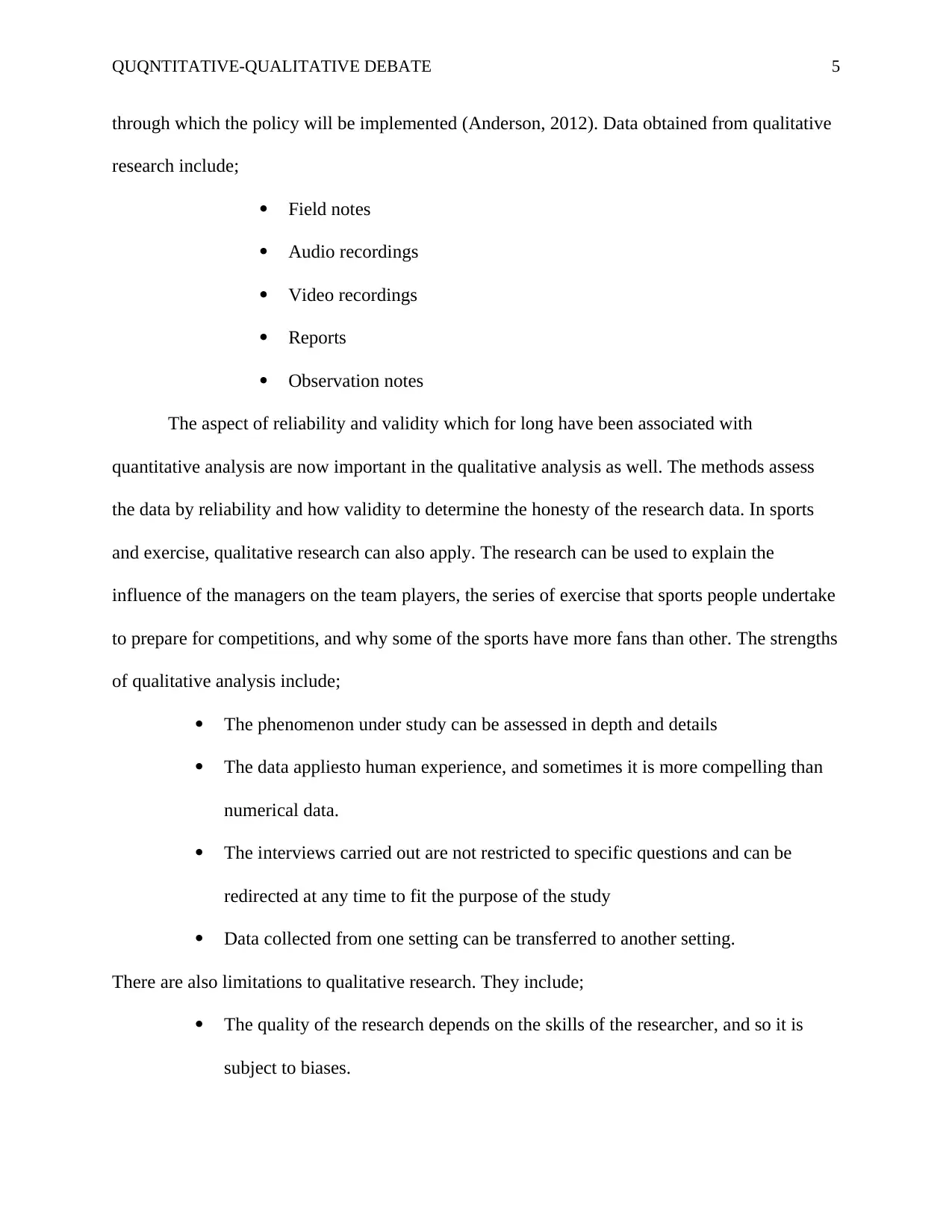
QUQNTITATIVE-QUALITATIVE DEBATE 5
through which the policy will be implemented (Anderson, 2012). Data obtained from qualitative
research include;
Field notes
Audio recordings
Video recordings
Reports
Observation notes
The aspect of reliability and validity which for long have been associated with
quantitative analysis are now important in the qualitative analysis as well. The methods assess
the data by reliability and how validity to determine the honesty of the research data. In sports
and exercise, qualitative research can also apply. The research can be used to explain the
influence of the managers on the team players, the series of exercise that sports people undertake
to prepare for competitions, and why some of the sports have more fans than other. The strengths
of qualitative analysis include;
The phenomenon under study can be assessed in depth and details
The data appliesto human experience, and sometimes it is more compelling than
numerical data.
The interviews carried out are not restricted to specific questions and can be
redirected at any time to fit the purpose of the study
Data collected from one setting can be transferred to another setting.
There are also limitations to qualitative research. They include;
The quality of the research depends on the skills of the researcher, and so it is
subject to biases.
through which the policy will be implemented (Anderson, 2012). Data obtained from qualitative
research include;
Field notes
Audio recordings
Video recordings
Reports
Observation notes
The aspect of reliability and validity which for long have been associated with
quantitative analysis are now important in the qualitative analysis as well. The methods assess
the data by reliability and how validity to determine the honesty of the research data. In sports
and exercise, qualitative research can also apply. The research can be used to explain the
influence of the managers on the team players, the series of exercise that sports people undertake
to prepare for competitions, and why some of the sports have more fans than other. The strengths
of qualitative analysis include;
The phenomenon under study can be assessed in depth and details
The data appliesto human experience, and sometimes it is more compelling than
numerical data.
The interviews carried out are not restricted to specific questions and can be
redirected at any time to fit the purpose of the study
Data collected from one setting can be transferred to another setting.
There are also limitations to qualitative research. They include;
The quality of the research depends on the skills of the researcher, and so it is
subject to biases.
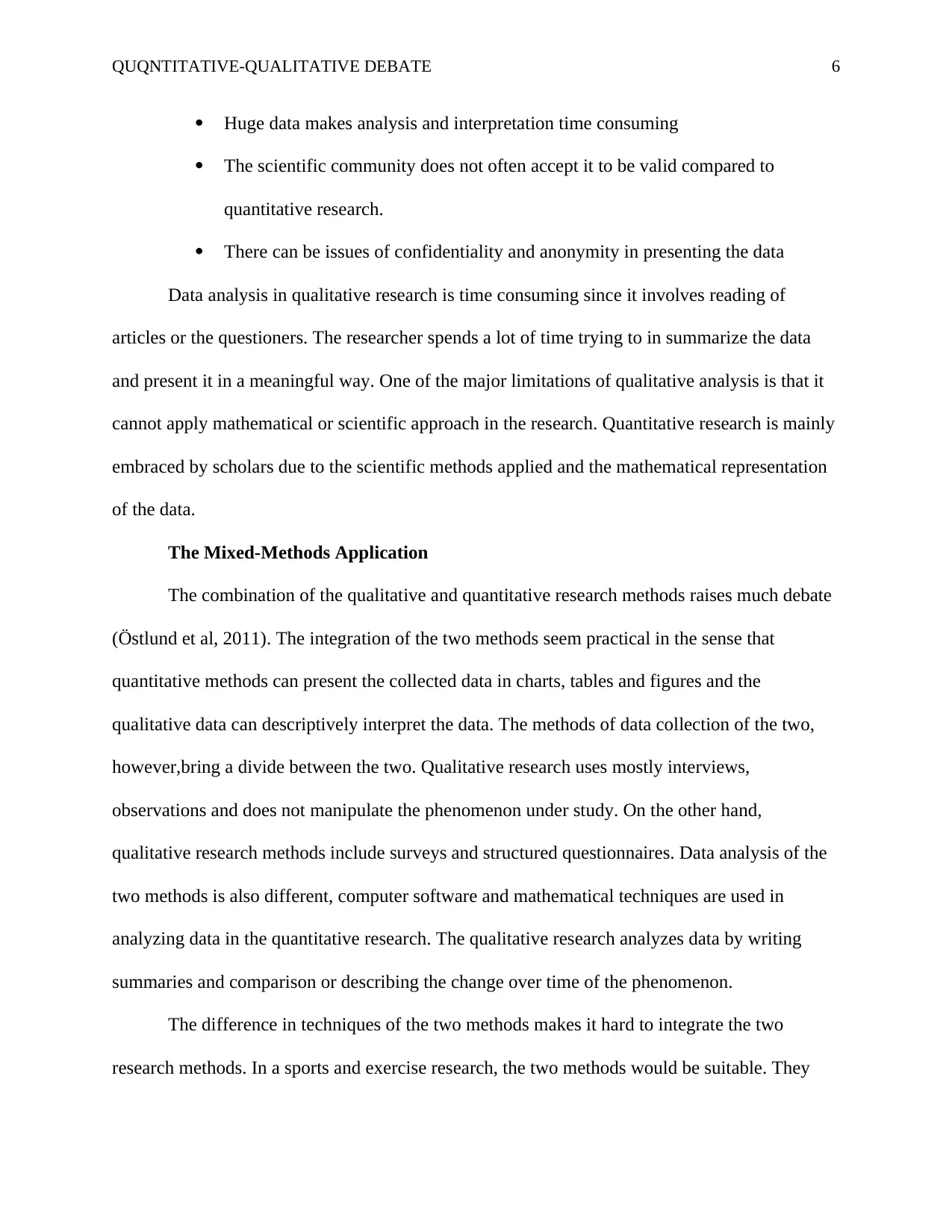
QUQNTITATIVE-QUALITATIVE DEBATE 6
Huge data makes analysis and interpretation time consuming
The scientific community does not often accept it to be valid compared to
quantitative research.
There can be issues of confidentiality and anonymity in presenting the data
Data analysis in qualitative research is time consuming since it involves reading of
articles or the questioners. The researcher spends a lot of time trying to in summarize the data
and present it in a meaningful way. One of the major limitations of qualitative analysis is that it
cannot apply mathematical or scientific approach in the research. Quantitative research is mainly
embraced by scholars due to the scientific methods applied and the mathematical representation
of the data.
The Mixed-Methods Application
The combination of the qualitative and quantitative research methods raises much debate
(Östlund et al, 2011). The integration of the two methods seem practical in the sense that
quantitative methods can present the collected data in charts, tables and figures and the
qualitative data can descriptively interpret the data. The methods of data collection of the two,
however,bring a divide between the two. Qualitative research uses mostly interviews,
observations and does not manipulate the phenomenon under study. On the other hand,
qualitative research methods include surveys and structured questionnaires. Data analysis of the
two methods is also different, computer software and mathematical techniques are used in
analyzing data in the quantitative research. The qualitative research analyzes data by writing
summaries and comparison or describing the change over time of the phenomenon.
The difference in techniques of the two methods makes it hard to integrate the two
research methods. In a sports and exercise research, the two methods would be suitable. They
Huge data makes analysis and interpretation time consuming
The scientific community does not often accept it to be valid compared to
quantitative research.
There can be issues of confidentiality and anonymity in presenting the data
Data analysis in qualitative research is time consuming since it involves reading of
articles or the questioners. The researcher spends a lot of time trying to in summarize the data
and present it in a meaningful way. One of the major limitations of qualitative analysis is that it
cannot apply mathematical or scientific approach in the research. Quantitative research is mainly
embraced by scholars due to the scientific methods applied and the mathematical representation
of the data.
The Mixed-Methods Application
The combination of the qualitative and quantitative research methods raises much debate
(Östlund et al, 2011). The integration of the two methods seem practical in the sense that
quantitative methods can present the collected data in charts, tables and figures and the
qualitative data can descriptively interpret the data. The methods of data collection of the two,
however,bring a divide between the two. Qualitative research uses mostly interviews,
observations and does not manipulate the phenomenon under study. On the other hand,
qualitative research methods include surveys and structured questionnaires. Data analysis of the
two methods is also different, computer software and mathematical techniques are used in
analyzing data in the quantitative research. The qualitative research analyzes data by writing
summaries and comparison or describing the change over time of the phenomenon.
The difference in techniques of the two methods makes it hard to integrate the two
research methods. In a sports and exercise research, the two methods would be suitable. They
⊘ This is a preview!⊘
Do you want full access?
Subscribe today to unlock all pages.

Trusted by 1+ million students worldwide
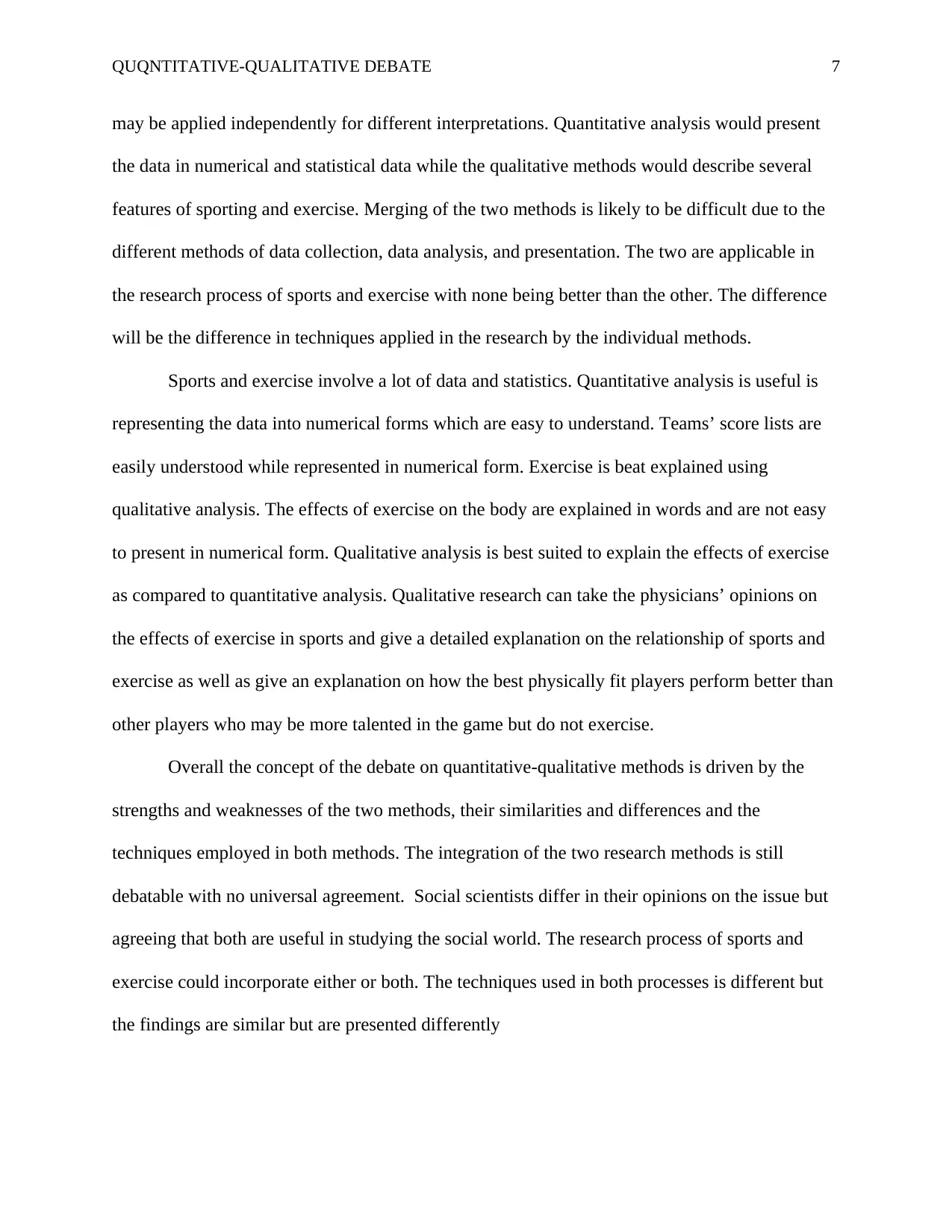
QUQNTITATIVE-QUALITATIVE DEBATE 7
may be applied independently for different interpretations. Quantitative analysis would present
the data in numerical and statistical data while the qualitative methods would describe several
features of sporting and exercise. Merging of the two methods is likely to be difficult due to the
different methods of data collection, data analysis, and presentation. The two are applicable in
the research process of sports and exercise with none being better than the other. The difference
will be the difference in techniques applied in the research by the individual methods.
Sports and exercise involve a lot of data and statistics. Quantitative analysis is useful is
representing the data into numerical forms which are easy to understand. Teams’ score lists are
easily understood while represented in numerical form. Exercise is beat explained using
qualitative analysis. The effects of exercise on the body are explained in words and are not easy
to present in numerical form. Qualitative analysis is best suited to explain the effects of exercise
as compared to quantitative analysis. Qualitative research can take the physicians’ opinions on
the effects of exercise in sports and give a detailed explanation on the relationship of sports and
exercise as well as give an explanation on how the best physically fit players perform better than
other players who may be more talented in the game but do not exercise.
Overall the concept of the debate on quantitative-qualitative methods is driven by the
strengths and weaknesses of the two methods, their similarities and differences and the
techniques employed in both methods. The integration of the two research methods is still
debatable with no universal agreement. Social scientists differ in their opinions on the issue but
agreeing that both are useful in studying the social world. The research process of sports and
exercise could incorporate either or both. The techniques used in both processes is different but
the findings are similar but are presented differently
may be applied independently for different interpretations. Quantitative analysis would present
the data in numerical and statistical data while the qualitative methods would describe several
features of sporting and exercise. Merging of the two methods is likely to be difficult due to the
different methods of data collection, data analysis, and presentation. The two are applicable in
the research process of sports and exercise with none being better than the other. The difference
will be the difference in techniques applied in the research by the individual methods.
Sports and exercise involve a lot of data and statistics. Quantitative analysis is useful is
representing the data into numerical forms which are easy to understand. Teams’ score lists are
easily understood while represented in numerical form. Exercise is beat explained using
qualitative analysis. The effects of exercise on the body are explained in words and are not easy
to present in numerical form. Qualitative analysis is best suited to explain the effects of exercise
as compared to quantitative analysis. Qualitative research can take the physicians’ opinions on
the effects of exercise in sports and give a detailed explanation on the relationship of sports and
exercise as well as give an explanation on how the best physically fit players perform better than
other players who may be more talented in the game but do not exercise.
Overall the concept of the debate on quantitative-qualitative methods is driven by the
strengths and weaknesses of the two methods, their similarities and differences and the
techniques employed in both methods. The integration of the two research methods is still
debatable with no universal agreement. Social scientists differ in their opinions on the issue but
agreeing that both are useful in studying the social world. The research process of sports and
exercise could incorporate either or both. The techniques used in both processes is different but
the findings are similar but are presented differently
Paraphrase This Document
Need a fresh take? Get an instant paraphrase of this document with our AI Paraphraser
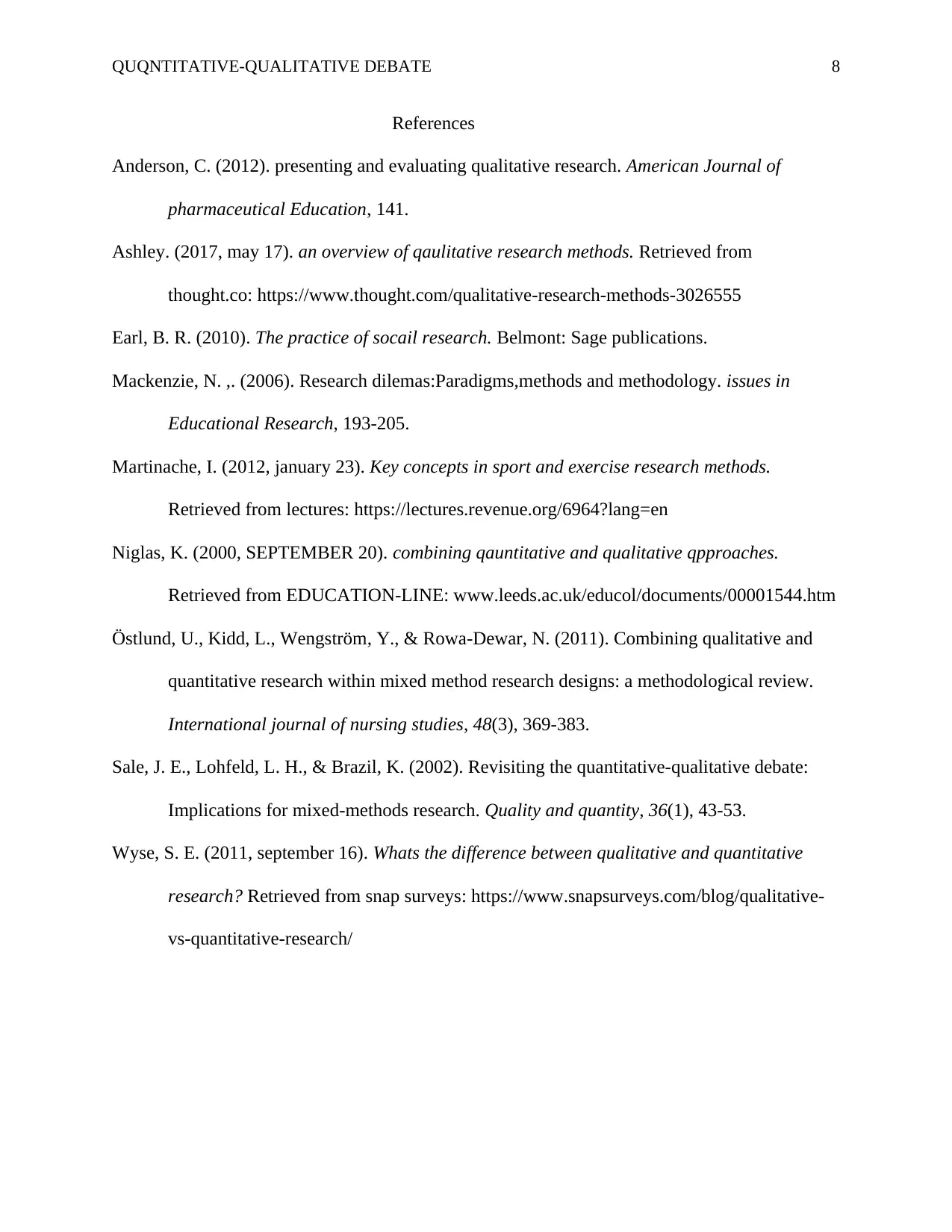
QUQNTITATIVE-QUALITATIVE DEBATE 8
References
Anderson, C. (2012). presenting and evaluating qualitative research. American Journal of
pharmaceutical Education, 141.
Ashley. (2017, may 17). an overview of qaulitative research methods. Retrieved from
thought.co: https://www.thought.com/qualitative-research-methods-3026555
Earl, B. R. (2010). The practice of socail research. Belmont: Sage publications.
Mackenzie, N. ,. (2006). Research dilemas:Paradigms,methods and methodology. issues in
Educational Research, 193-205.
Martinache, I. (2012, january 23). Key concepts in sport and exercise research methods.
Retrieved from lectures: https://lectures.revenue.org/6964?lang=en
Niglas, K. (2000, SEPTEMBER 20). combining qauntitative and qualitative qpproaches.
Retrieved from EDUCATION-LINE: www.leeds.ac.uk/educol/documents/00001544.htm
Östlund, U., Kidd, L., Wengström, Y., & Rowa-Dewar, N. (2011). Combining qualitative and
quantitative research within mixed method research designs: a methodological review.
International journal of nursing studies, 48(3), 369-383.
Sale, J. E., Lohfeld, L. H., & Brazil, K. (2002). Revisiting the quantitative-qualitative debate:
Implications for mixed-methods research. Quality and quantity, 36(1), 43-53.
Wyse, S. E. (2011, september 16). Whats the difference between qualitative and quantitative
research? Retrieved from snap surveys: https://www.snapsurveys.com/blog/qualitative-
vs-quantitative-research/
References
Anderson, C. (2012). presenting and evaluating qualitative research. American Journal of
pharmaceutical Education, 141.
Ashley. (2017, may 17). an overview of qaulitative research methods. Retrieved from
thought.co: https://www.thought.com/qualitative-research-methods-3026555
Earl, B. R. (2010). The practice of socail research. Belmont: Sage publications.
Mackenzie, N. ,. (2006). Research dilemas:Paradigms,methods and methodology. issues in
Educational Research, 193-205.
Martinache, I. (2012, january 23). Key concepts in sport and exercise research methods.
Retrieved from lectures: https://lectures.revenue.org/6964?lang=en
Niglas, K. (2000, SEPTEMBER 20). combining qauntitative and qualitative qpproaches.
Retrieved from EDUCATION-LINE: www.leeds.ac.uk/educol/documents/00001544.htm
Östlund, U., Kidd, L., Wengström, Y., & Rowa-Dewar, N. (2011). Combining qualitative and
quantitative research within mixed method research designs: a methodological review.
International journal of nursing studies, 48(3), 369-383.
Sale, J. E., Lohfeld, L. H., & Brazil, K. (2002). Revisiting the quantitative-qualitative debate:
Implications for mixed-methods research. Quality and quantity, 36(1), 43-53.
Wyse, S. E. (2011, september 16). Whats the difference between qualitative and quantitative
research? Retrieved from snap surveys: https://www.snapsurveys.com/blog/qualitative-
vs-quantitative-research/

QUQNTITATIVE-QUALITATIVE DEBATE 9
⊘ This is a preview!⊘
Do you want full access?
Subscribe today to unlock all pages.

Trusted by 1+ million students worldwide
1 out of 9
Related Documents
Your All-in-One AI-Powered Toolkit for Academic Success.
+13062052269
info@desklib.com
Available 24*7 on WhatsApp / Email
![[object Object]](/_next/static/media/star-bottom.7253800d.svg)
Unlock your academic potential
Copyright © 2020–2025 A2Z Services. All Rights Reserved. Developed and managed by ZUCOL.




